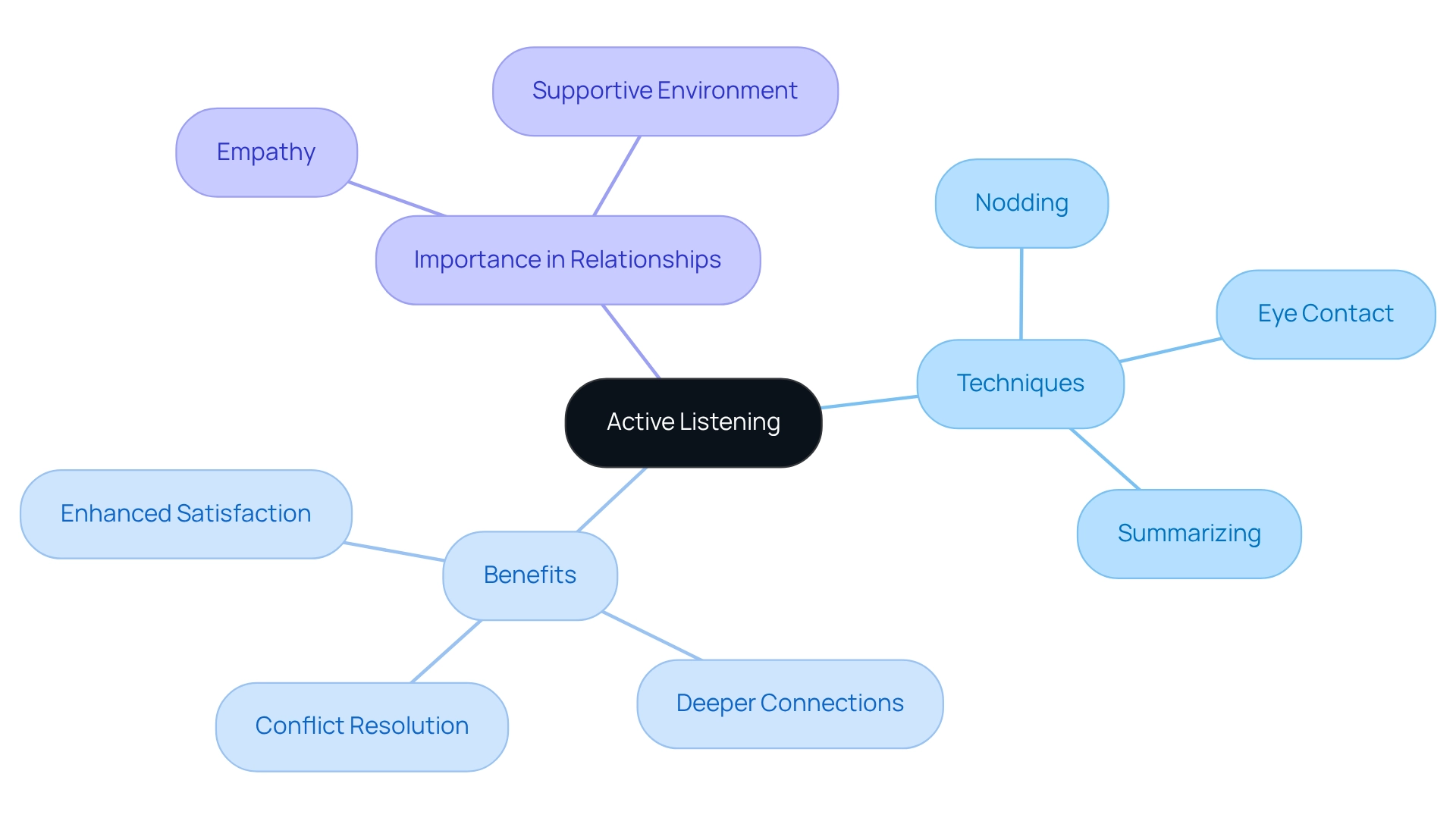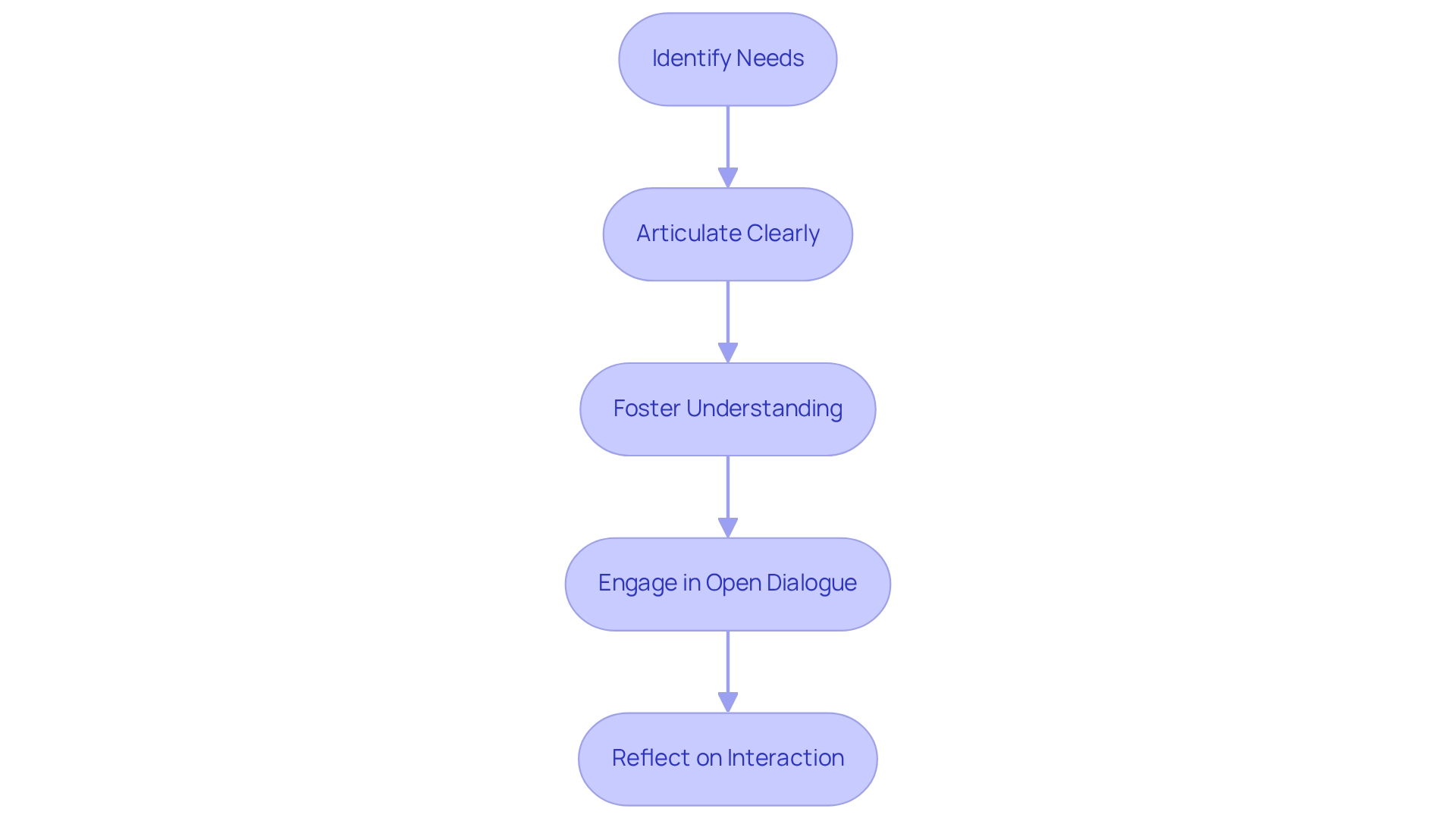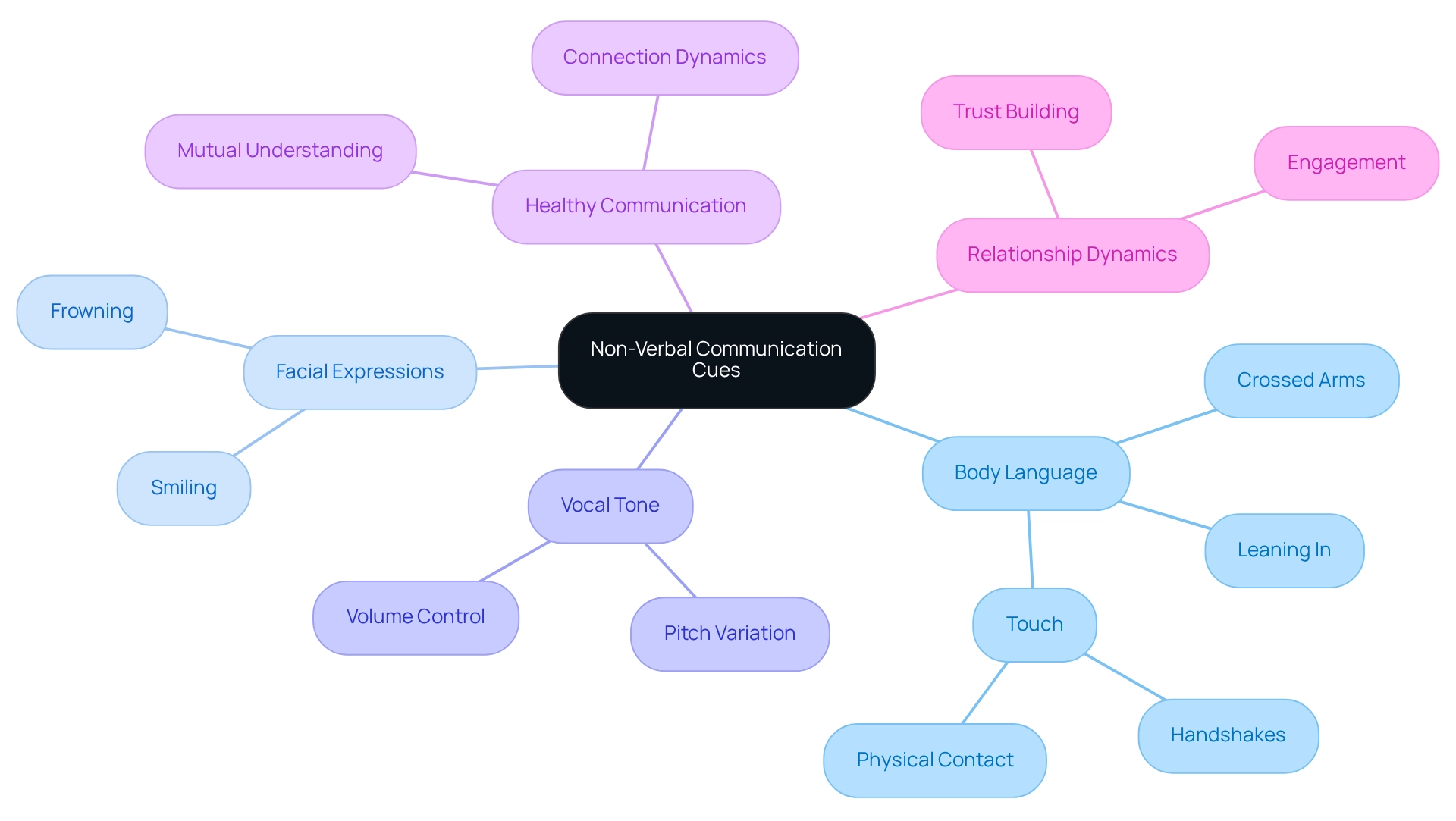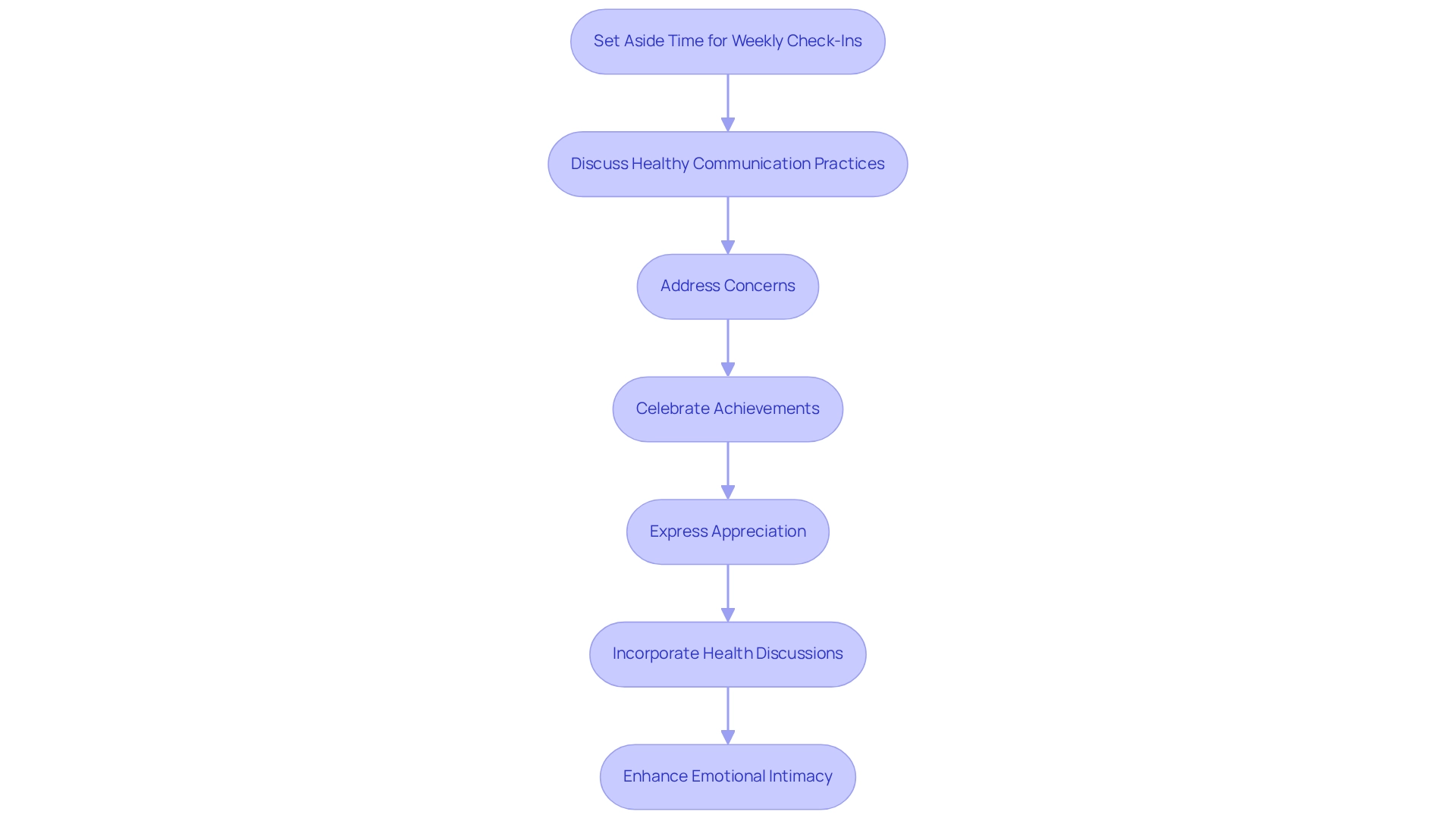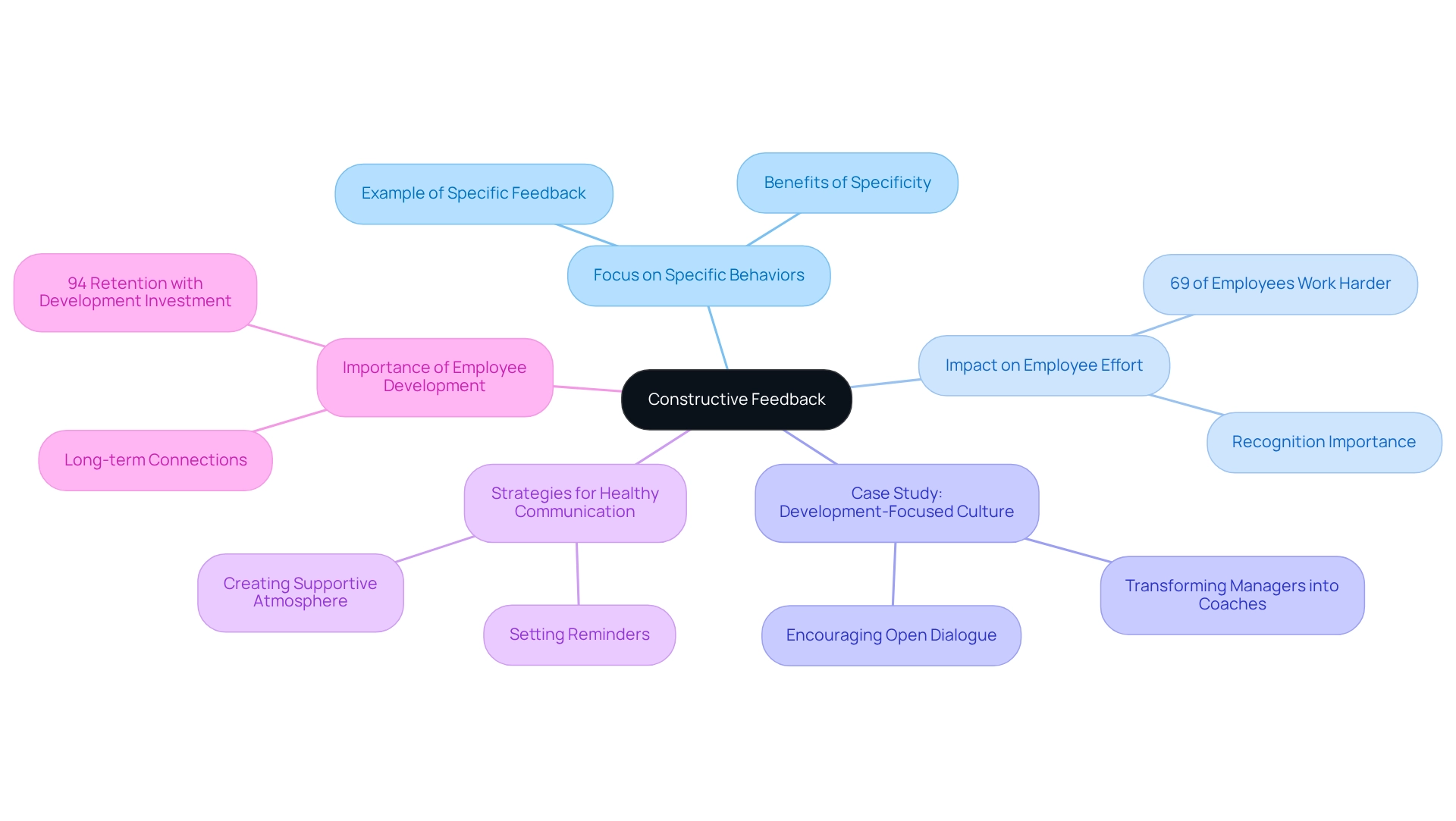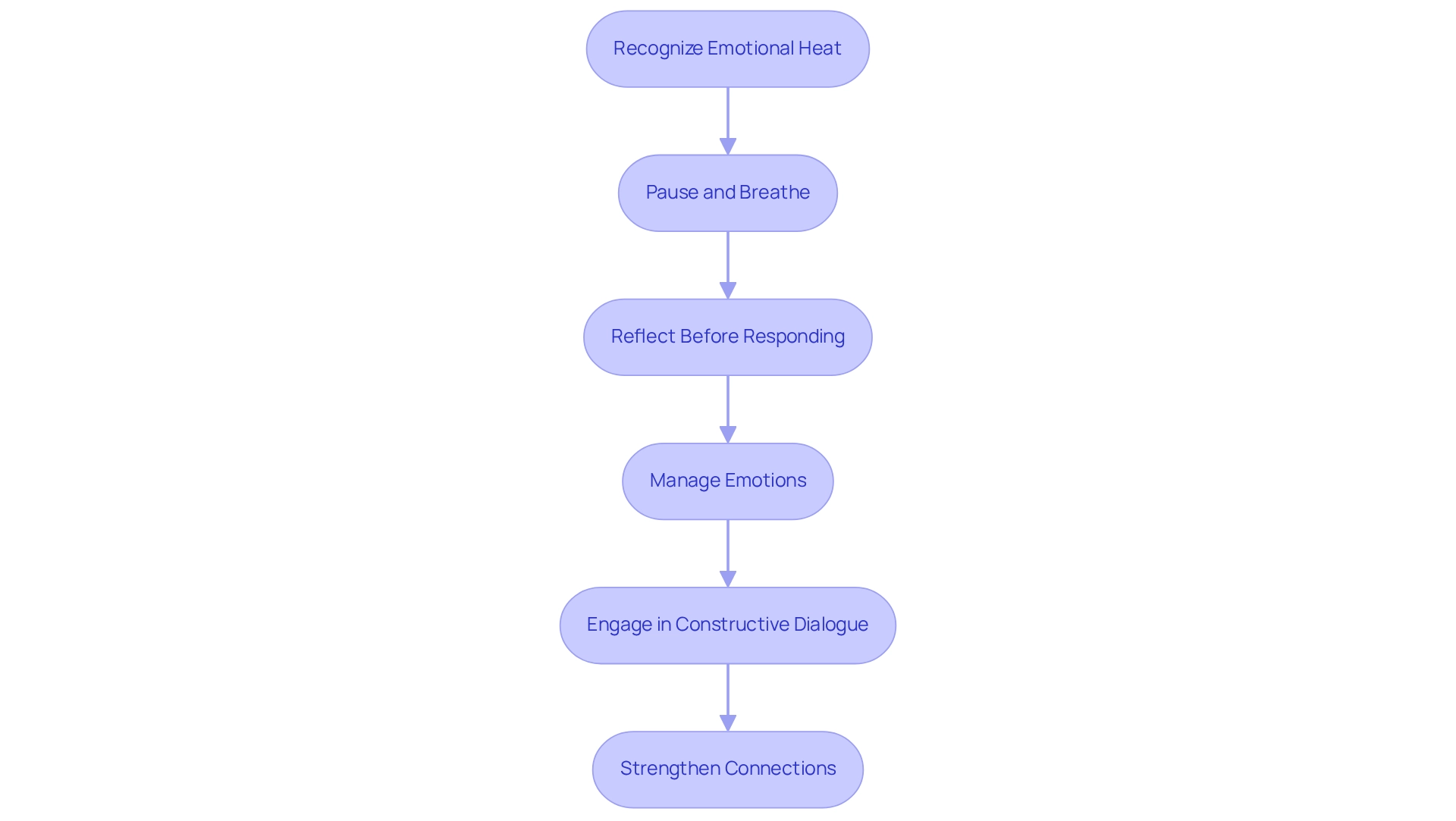Overview
The couple is nurturing their relationship through healthy communication techniques, such as:
- active listening
- using ‘I’ statements
- cultivating empathy
These practices not only foster a deeper understanding and connection but also create a supportive environment. It’s important to recognize that these methods can significantly enhance relationship satisfaction. Evidence suggests that they help partners navigate sensitive discussions effectively, ultimately leading to a more fulfilling partnership. Many couples find that embracing these strategies transforms their interactions and strengthens their bond.
Introduction
In the intricate tapestry of relationships, effective communication serves as the thread that weaves partners together. It’s important to recognize that as couples navigate the complexities of love and understanding, the ability to express thoughts and feelings clearly becomes paramount.
From the power of active listening to the subtleties of non-verbal cues, each aspect of communication plays a vital role in fostering deeper connections. Many couples find that embracing these techniques not only strengthens their emotional bonds but also creates a more harmonious environment, especially when facing challenges like health issues.
This article delves into essential strategies that couples can employ to enhance their interactions, ensuring that both partners feel heard, valued, and supported.
Prioritize Active Listening in Conversations
Active listening is an essential skill that involves fully engaging with your companion’s words, rather than merely hearing them. This practice includes techniques such as nodding, maintaining eye contact, and summarizing your companion’s statements to ensure mutual understanding. By showing respect and attentiveness, active listening fosters an atmosphere conducive to open dialogue, enabling partners to discuss sensitive subjects without escalating tensions.
It’s important to recognize that studies show effective listening significantly enhances satisfaction in relationships. A study by the Center for Creative Leadership found that individuals who practice active listening are perceived as more effective communicators, leading to deeper connections and increased engagement. Many patients find that in relationship therapy, effective interaction methods frequently center on active listening, which not only strengthens connections but also aids in resolving disputes.
As we move into 2025, the emphasis on active listening techniques continues to grow, with partners encouraged to exercise empathy by understanding their significant other’s perspective without bias. This approach not only bridges generational and cultural gaps but also nurtures a unified partnership. By prioritizing active listening, couples can enhance their satisfaction and cultivate a more supportive and understanding environment.
How is this couple practicing healthy communication? This question is particularly relevant for those managing health challenges like type 2 diabetes. Supporting one another through effective dialogue can lead to improved health outcomes and a more fulfilling partnership, especially for patients seeking guidance from specialists like Dr. Jason Shumard at Integrative Wellness Center, who focuses on reversing type 2 diabetes and hypothyroidism.
Utilize ‘I’ Statements to Express Feelings
Instead of saying, ‘You never listen to me,’ consider expressing your feelings with an ‘I’ statement: ‘I feel ignored when you look at your phone while I’m talking.’ This approach reduces blame and encourages a more constructive dialogue about your needs. It’s important to recognize how this couple is practicing healthy communication. Research indicates that utilizing ‘I’ statements can greatly improve communication effectiveness, prompting us to explore how this couple is fostering healthier interpersonal dynamics.
For instance, a study on young adult couples revealed that accusations of infidelity often stem from feelings of neglect. Addressing emotions directly can invite repair rather than conflict. This study identifies a 5-part sequential pattern in these interactions, suggesting that such accusations are part of a cultural pattern aimed at maintaining close relationships. By focusing on personal feelings rather than assigning blame, individuals can create an environment conducive to understanding and support. How is this couple practicing healthy communication?
As one expert suggests, ‘Instead of concentrating on what’s going wrong, use I-Statements to express your feelings and propose specific ways your significant other can assist you.’ This method not only reduces conflict but also enables partners to engage in meaningful discussions, ultimately enhancing their bond. Many patients find that by adopting this approach, they can significantly improve their relationships and foster a deeper connection.
Cultivate Empathy and Understanding
To cultivate empathy, consider how this couple is practicing healthy communication. How can you actively step into your significant other’s shoes? Engage in open-ended conversations that invite them to share their feelings and experiences, ensuring you validate their emotions. Phrases such as, ‘I can see why you feel that way,’ can significantly enhance your significant other’s sense of being understood and valued.
It’s important to recognize that research shows negative empathy—disregarding or downplaying a partner’s emotions—can greatly impact the quality of connections, with a distinct variance of 0.68 in dynamics attributed to it. By fostering an empathetic environment, couples can improve their communication, leading to deeper connections and a more supportive partnership.
How is this couple practicing healthy communication? Consider all that applies. Many patients find that when they are educated about their health conditions, they express gratitude for the knowledge gained, empowering them to manage their health more effectively. For instance, one patient from Dr. Jason Shumard‘s 30-Day Diabetes Reset program shared, ‘I lost 55 lbs. My A1C started at 9.1 after 8 months; it is now 5.7.’
This empowerment reflects the dynamics of healthy connections, where understanding and empathy play crucial roles in nurturing emotional ties. As Dr. Jason Shumard states, ‘By offering patients actionable insights and practical tools, the center cultivates an environment where individuals can regain their health and well-being.’ This emphasizes the transformative power of empathy and understanding in both health and connections.
Ensure Clarity and Directness in Messages
Efficient dialogue is essential in any connection. So, how is this couple practicing healthy communication? Let’s explore this together, especially when addressing important subjects. To foster understanding and connection, consider how this couple practices healthy communication. Check all that apply to being clear and direct in their messages. Instead of using vague language, articulate your needs explicitly. For example, rather than saying, ‘I need more help around the house,’ specify your request: ‘I would appreciate it if you could help with the dishes on Wednesdays.’ This degree of clarity not only assists your partner in understanding your expectations but also invites us to reflect on how this couple practices healthy communication, thereby reducing misunderstandings.
Research suggests that clarity in interactions can greatly improve relationship satisfaction. So, how is this couple practicing healthy communication? A study discovered that couples who engage in open dialogue report higher levels of fulfillment in their partnerships. Grasping and utilizing relational interaction skills can lead to a more satisfying marriage, emphasizing the significance of effective dialogue. Moreover, efficient interaction abilities are not only advantageous for personal connections; they are also essential in workplace environments. Case studies demonstrate that leaders who enhance their interpersonal skills cultivate improved team dynamics and project results, highlighting the universal significance of clear dialogue.
In relationships, it’s important to ask how is this couple practicing healthy communication. Articulating needs clearly can result in more rewarding interactions. Expert advice indicates that direct interaction helps partners feel more connected and understood, which raises the question of how is this couple practicing healthy communication, ultimately strengthening their bond. Furthermore, statistics show that 70% of psychotherapists assist partners using online platforms, making resources for enhancing interaction more reachable. By prioritizing clarity in your conversations and addressing interaction issues proactively—similar to couples who seek therapy early and report better outcomes—you can create a more supportive and harmonious relationship environment. As Mireia Borrell-Porta observes, gender norm attitudes can significantly influence interaction dynamics, further emphasizing the need for clarity and directness in messages.
Recognize Non-Verbal Communication Cues
During conversations, being attuned to your companion’s body language and facial expressions raises an important question: how is this couple practicing healthy communication? Consider this as you observe. For instance, crossed arms may signal defensiveness, while leaning in often indicates engagement and interest. By recognizing these non-verbal cues, you can tailor your communication style, fostering a deeper connection with your significant other.
It’s essential to reflect on how this couple demonstrates healthy communication. According to the 7-38-55 rule, only 7% of meaning is conveyed through words, while 38% comes from vocal tone and a significant 55% from body language. This underscores the importance of being aware of how you and your partner express feelings beyond words.
How is this couple practicing healthy communication? By reacting to these signals, you can improve mutual understanding and reinforce your connection dynamics. Consider how this couple is practicing healthy communication.
Furthermore, Dr. Shumard’s methodologies provide actionable insights that empower patients to navigate their health journeys more effectively. Understanding the nuances of touch, as highlighted in case studies, can also help establish authenticity and trust in your interactions.
As Allan and Barbara Pease observed, body language represents the majority of influence exerted during negotiations, highlighting its essential role in all types of interaction, including within relationships.
Conduct Regular Communication Check-Ins
Set aside time each week to check in on discussions about how this couple is practicing healthy communication. Check all that apply. This dedicated space allows collaborators to address concerns, celebrate achievements, and express appreciation, fostering a deeper connection. Regular interaction check-ins not only strengthen your bond but also ensure that both partners feel acknowledged and valued. This naturally leads us to ask: how is this couple practicing healthy communication? Check all that apply to sustain healthy connections.
Studies show that partners who engage in regular communication report higher satisfaction levels, prompting us to reflect on how this couple is practicing healthy communication. Check all that apply. Dr. Jason Shumard emphasizes the importance of providing patients with actionable insights and practical tools, particularly for those managing type 2 diabetes. Creating an environment where individuals can reclaim their health and well-being is essential.
Furthermore, research indicates that partners who prioritize open dialogue about their health challenges, such as managing diabetes, can enhance emotional intimacy and understanding. This raises the question: how is this couple practicing healthy communication? Check all that apply. By incorporating health discussions into these check-ins, couples can navigate challenges more effectively and cultivate a supportive atmosphere that strengthens their bond, ultimately empowering them to overcome the obstacles associated with type 2 diabetes.
Establish and Respect Boundaries
Setting and honoring personal boundaries with your partner is essential for nurturing a healthy connection. This includes:
- Setting aside time for individual activities
- Maintaining privacy regarding personal matters
- Defining emotional boundaries during conflicts
Such boundaries not only protect individual well-being but also enhance mutual respect and understanding.
It’s important to recognize that effective boundary setting is vital across various demographics. Statistics reveal that:
- 18% of respondents identify as Gen Z
- 50% as Millennials
- 22% as Gen X
- 10% as Baby Boomers
Understanding how these groups approach boundary setting can provide insights into the universal relevance of this issue.
How is this couple practicing healthy communication? Check all that apply. Expert advice emphasizes that clear communication about boundaries can lead to more fulfilling partnerships. For example, partners who dedicate time to establishing and maintaining emotional boundaries frequently indicate enhanced satisfaction in their connection.
Furthermore, conveying boundaries is not only essential in personal connections but also in professional environments, as it aids in managing workload and stress. Many patients find that case studies, like those from Dr. Jason Shumard’s Functional Medicine Approach, demonstrate how individuals who learn to express their boundaries effectively experience transformative results in their health and connections. For instance, individuals who establish clear limits concerning their health management often express feeling more empowered and in control, resulting in improved health outcomes.
As we adopt the notion that ‘2023 is a time to begin anew,’ prioritizing boundary setting can act as a new beginning for partners. Couples can improve their satisfaction in the partnership by fostering a supportive atmosphere that promotes personal development and deepens their bond.
How is this couple practicing healthy communication? Check all that apply. To take actionable steps, reflect on your own boundaries and consider how you can communicate them effectively with your partner.
Provide Constructive Feedback to Each Other
When offering feedback, it’s important to focus on specific behaviors instead of generalizations. For example, rather than saying, ‘You always forget things,’ a more constructive approach would be, ‘I noticed you forgot to pick up the groceries yesterday. Can we set a reminder for next time?’ This method not only clarifies the issue but also creates a supportive atmosphere that nurtures growth. Research shows that specific feedback significantly enhances interpersonal dynamics, fostering trust and understanding. Did you know that a Gallup poll reveals 69% of employees would exert more effort if they felt recognized? This highlights the broader impact of constructive communication.
Moreover, a case study titled ‘Creating a Development-Focused Culture‘ demonstrates how leaders can cultivate a culture of meaningful feedback, which is equally relevant in personal connections. By investing in constructive feedback, couples can reflect on how they practice healthy communication. What strategies can you adopt to cultivate a more positive and productive bond? This ultimately leads to deeper connections and mutual respect. Furthermore, statistics show that 94% of employees will stay longer with a company that invests in their development, emphasizing the importance of constructive feedback in nurturing long-term connections, both personally and professionally.
Practice Patience During Discussions
In the heat of discussions, especially when emotions run high, one might wonder: how is this couple practicing healthy communication? It’s essential to pause and take a deep breath before responding. This brief moment of reflection can significantly reduce impulsive reactions, fostering a more thoughtful and constructive dialogue. Cultivating patience enables individuals to manage their emotions effectively, leading to clearer expression. So, how is this couple practicing healthy communication? Reflect on this to achieve improved outcomes.
Research indicates that emotional processing during discussions is vital. When individuals take the time to manage their feelings, they are more likely to engage in productive conversations. This prompts the question: how is this couple practicing healthy communication? Consider this as you reflect. In fact, a study found that 24% of workers stated they did not experience any positive outcomes from conflicts, highlighting the importance of patience in achieving better results.
By fostering this habit, not only can conflicts be resolved more amicably, but connections can also be strengthened, paving the way for healthier interactions. How is this couple practicing healthy communication? Think about this as you engage in your own discussions. As Joseph Addison wisely noted, ‘Our real blessings often appear to us in the shape of pains, losses, and disappointments; but let us have patience and we soon shall see them in their proper figures.’ This perspective reinforces the idea that real blessings often come disguised as challenges, requiring patience to recognize and appreciate them.
Address Conflicts Calmly and Respectfully
When conflicts arise, it’s important to approach them with a calm demeanor. Utilizing phrases such as, ‘I understand we disagree, but let’s find a solution together,’ invites reflection on how this couple is practicing healthy communication. Check all that apply to foster a collaborative atmosphere. This respectful manner of interaction not only encourages cooperation but also ensures that both partners feel valued, significantly reducing defensiveness. Research indicates that 24% of individuals reported no positive outcomes from conflicts, highlighting the need for effective resolution strategies in personal connections. By addressing conflicts respectfully, couples can re-establish a healthy dynamic, ultimately enhancing their connection and overall well-being.
Planning for future conflicts involves anticipating disagreements and developing strategies for constructive communication. Effective strategies for calm conflict resolution include:
- Actively listening
- Acknowledging each other’s feelings
- Focusing on solutions rather than blame
How is this couple practicing healthy communication? Check all that apply. Organized conflict resolution methods, as emphasized in case studies, can lead to enhanced connections and a healthier atmosphere at home. As Jeremy Pollack, founder of Pollack Peacebuilding Systems, observes, ‘We’re passionate about assisting in fostering and restoring connections at work, at home, and in communities.’ This underscores the importance of respectful conflict resolution in nurturing strong, supportive relationships, essential for maintaining good health and managing conditions like type 2 diabetes.
Conclusion
Effective communication truly serves as the cornerstone of strong relationships. It’s essential to recognize that prioritizing active listening, utilizing ‘I’ statements, and cultivating empathy are vital components for fostering deeper connections between partners. Many couples find that recognizing non-verbal cues and ensuring clarity in messages significantly enhances understanding. Regular communication check-ins can also provide a structured approach to maintaining emotional intimacy.
Additionally, establishing and respecting boundaries contributes to a healthier dynamic. This allows individuals to express their needs without fear of judgment. Providing constructive feedback and practicing patience during discussions can transform conflicts into opportunities for growth. It reinforces the importance of addressing issues calmly and respectfully. Each of these strategies not only improves communication but also empowers couples to navigate challenges together, particularly in the context of health-related issues.
Ultimately, the journey of enhancing communication within a relationship is ongoing and requires commitment from both partners. By embracing these techniques, couples can create a supportive environment where both individuals feel heard, valued, and understood. This commitment not only strengthens emotional bonds but also promotes overall well-being, making effective communication an invaluable investment in the health of any partnership.
Frequently Asked Questions
What is active listening and why is it important?
Active listening is a skill that involves fully engaging with a person’s words, using techniques such as nodding, maintaining eye contact, and summarizing their statements. It is important because it fosters mutual understanding, respect, and attentiveness, creating an environment conducive to open dialogue, especially during sensitive discussions.
How does active listening affect relationships?
Studies show that effective listening enhances satisfaction in relationships. Individuals who practice active listening are seen as more effective communicators, which leads to deeper connections and increased engagement. It is often emphasized in relationship therapy to strengthen connections and resolve disputes.
How can active listening bridge generational and cultural gaps?
By exercising empathy and understanding a partner’s perspective without bias, active listening helps bridge generational and cultural gaps, nurturing a unified partnership.
What communication techniques can improve dialogue in relationships?
Using ‘I’ statements instead of accusatory language can improve communication. For example, saying ‘I feel ignored when you look at your phone while I’m talking’ reduces blame and encourages constructive dialogue about needs.
What is the significance of addressing emotions in communication?
Addressing emotions directly can invite repair rather than conflict. Research indicates that many relationship issues stem from feelings of neglect, and focusing on personal feelings rather than assigning blame fosters understanding and support.
How can couples cultivate empathy in their communication?
Couples can cultivate empathy by engaging in open-ended conversations that invite sharing of feelings and experiences. Validating each other’s emotions with phrases like ‘I can see why you feel that way’ enhances the sense of being understood and valued.
What impact does negative empathy have on relationships?
Negative empathy, which involves disregarding or downplaying a partner’s emotions, can significantly harm the quality of connections, leading to poorer relationship dynamics.
How can understanding and empathy affect health management in relationships?
Understanding and empathy play crucial roles in nurturing emotional ties, especially for patients managing health conditions. Educating patients about their health can empower them to manage their conditions more effectively, improving their overall well-being and relationship satisfaction.
